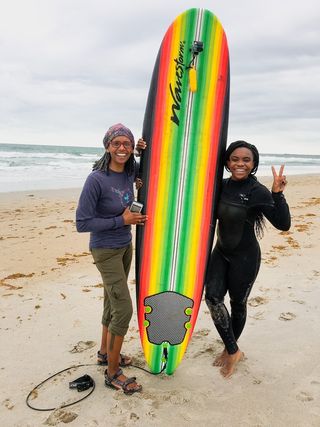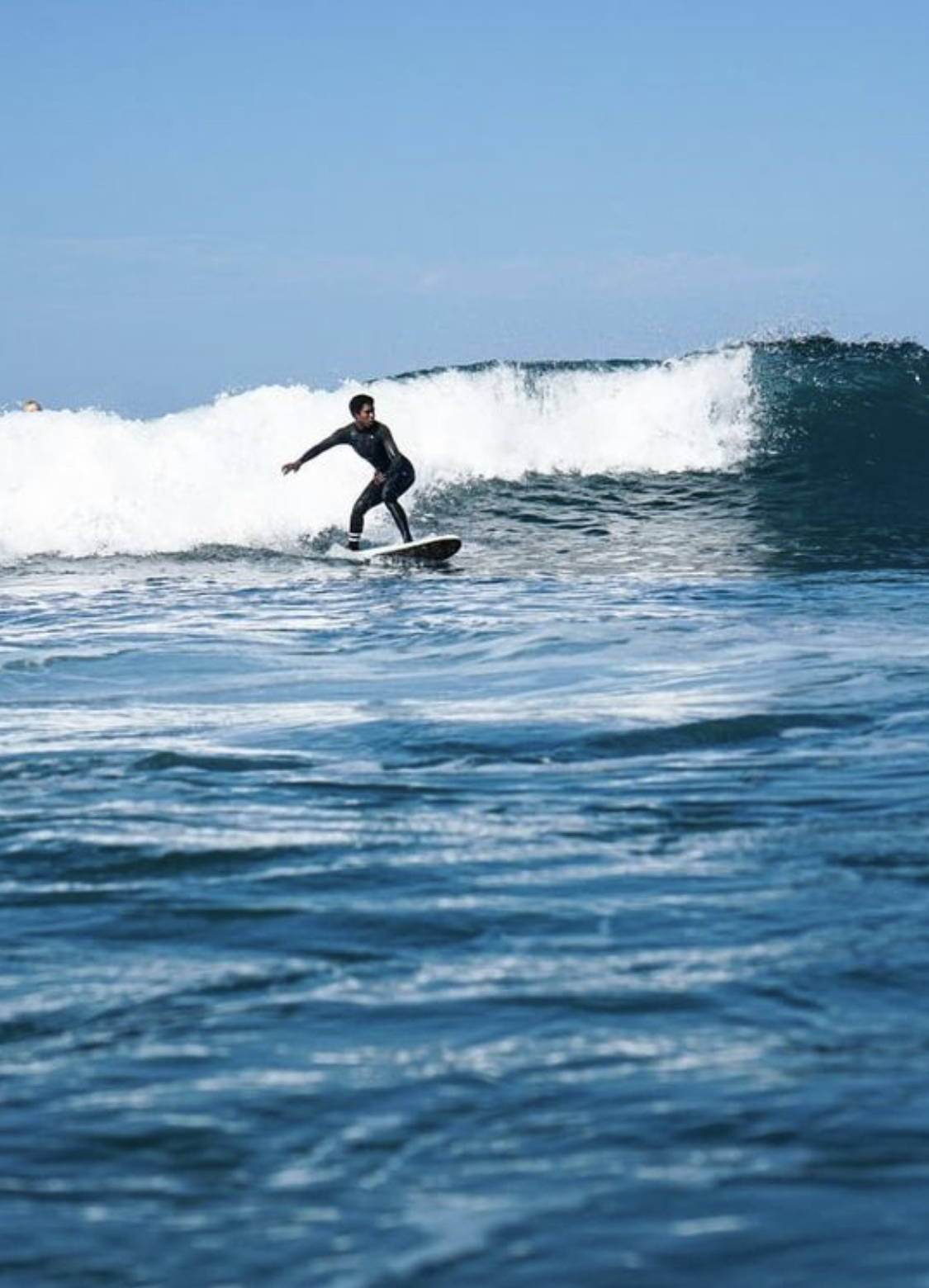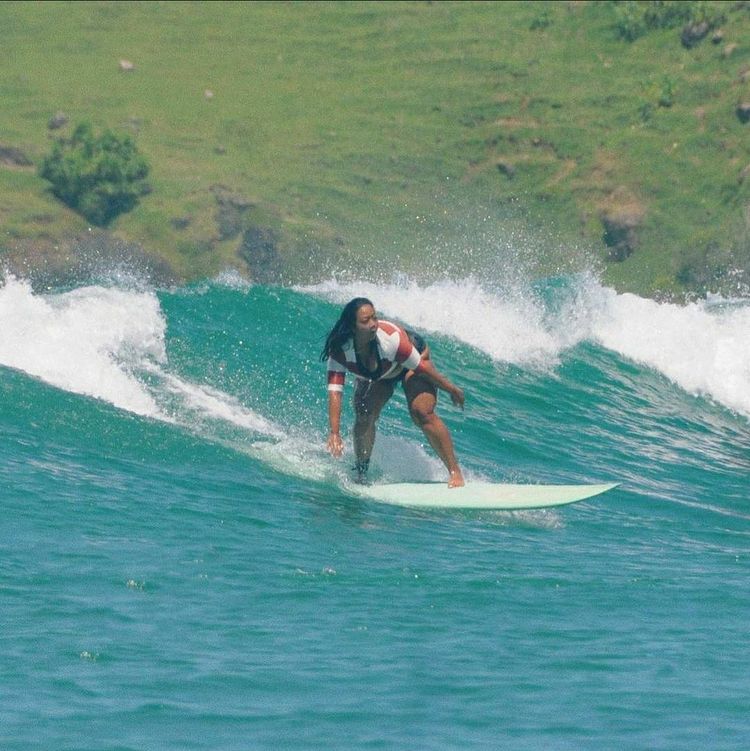
For years, the classic ‘surfer girl’ image has revolved around having tousled sun-bleached blonde hair, a deep tan and shell anklets. But, as writer Danai Nesta Kupemba has been finding out, that’s changing, with more and more women of colour grabbing their boards to surf the waves.
“I’ve only felt truly accepted in the water,” says 25-year-old North Carolina-based surfer Billie, who started surfing when she reached rock bottom, having been arrested on apparently trumped-up charges. At the time, she was living underneath a bridge in New York City. It was while surviving that situation that she stumbled across an Instagram page for Black surfers when scrolling on her phone. It was like an epiphany.
With $100 (£74) to her name, Billie moved to North Carolina, bought a longboard and hasn’t been off it since. She tells Stylist: “I was told that surfing was the only sport that if you turned away from it, you were conquered.
“I was tired of being conquered by society.”
You may also like
Swimming benefits: “How swimming can help boost self-esteem for Black women like me”
The first time Billie tried surfing, she paddled so far out that she nearly drowned. “It was raining and the riptides were strong,” she recalls. But that terrifying baptism didn’t put her off; once she’d mastered the basics, she knew that this was her thing. Her best surfing memory to date was realising that she was being cheered on by other surfers who she’d never met.
Surfing is an addiction, claims Bristolian Kristine Kahn, who at 50, has been surfing for 15 years. “It won’t let you walk away once it’s in your blood – you can’t leave it alone.” Like Billie, Kahn isn’t your typical surfer girl; without the blonde tresses and white skin, she’s a far-cry from the Lucie Donlans of this world.
The question is: why do we afford surfing such a tight, specific narrative and image? Growing up, Billie says that she was told that she couldn’t ever get her hair wet, that the sea wasn’t good for her skin and that sharks lurked close to the shore. “I was instilled with limited beliefs by people who had limited resources,” she explains.

Integrating surfing into communities of colour
Surfing has had a representation problem, at least in regard to how people outside of the community see its members. But in recent years, there’s been a real explosion of Black, brown, Latina and mixed women taking on the waves. Dominique Miller, an Afro-Latina pro surfer, was one of Billie’s key inspirations: “She’s does a phenomenal job in representing people of colour, and that’s what I’m trying to show other little girls – that they can paddle out with me and not worry about drowning.”
While Billie has been able to look up to Dominique Miller for inspiration, in the UK, Khan feels the sport hasn’t been integrated enough into communities of colour. “We need a whole generational shift in perspective to change that issue. Not as many people of colour live by the sea or have the privilege to travel there or the money to access the equipment or can swim,” she suggests.
Back on the other side of the pond, Divinity is another surfer who’s found peace in water. Growing up, her mother always took her and her brother to the beach every Sunday, and it didn’t take long for her to fall in love with the ocean. Divinity, who lives in LA, only started surfing in July 2020 as a quarantine hobby. She didn’t own a board or wetsuit, but knew that she had to be in the sea: “Surfing was always something I wanted to try, and I believe that when your inner child speaks, you follow the calling.”

Race, gender, equipment and localism are all barriers in surfing
For Divinity, surfing feels like a spiritual act. It’s been there for her during the toughest of times; she says that it’s when she’s surfing those waves that she feels most connected to her brother, who tragically died in 2016. “It feels like he’s living through me, guiding me along the waves and experiencing the moments he never had.”
It’s not just a racial reckoning that the surfing community has to wake up to, claims surfer Natasha.“There are a lot of things other than race or gender that ‘old school’ surfers don’t like, too. There’s localism, which is mixed with classism, and arguments about the sorts of equipment people use. I ride a soft-top surfboard which a lot of people from back in the day don’t like.” While things may be changing (largely thanks to the boost in popularity during the pandemic), Natasha says that she still gets stared at while surfing. “I get lots of looks especially after I prove I can surf, but now there are so many people in the water that even if there is hate, it’s quiet.”

Indonesian surfer Benita started surfing in late 2019 after she moved from Jakarta, which has no beaches, to Bali. Benita feels that diversity within the sport has a long way to go, but does think it is improving: “In Bali, surfing is full of white people, but I find the community is super lovely here. People are friendly and love to help each other. It’s a really great experience so far.”
Can fat people surf? Absolutely

So, women of colour are surfing around the world. But the diversity of bodies is still lacking and the dearth of plus-size bodies taking to the boards is something that Benita wants to challenge. “I doubted myself because I’ve never saw someone plus size surf. I even searched ‘Can fat people surf?’.
“Seeing more diverse body type representation is definitely needed. We all know that surfing is a competitive sport and that if you have a leaner body, you may surf better, but it doesn’t mean you can’t surf at all. As long as you have the right board, the right waves, and the right techniques, I believe everyone can surf.”
Clearly there are some barriers still stopping women from surfing: access, equipment, race and body diversity need to be addressed. But surfing can be a source of peace, solace, happiness, and most importantly, community.
Kahn’s advice to other women is this: “Just get in the water. It doesn’t even matter if you can’t stand up on the board, just to be in the sea will be the joy.”
Feeling inspired to get going? Test your stability with a Strong Women Training Club class first.
Images: Getty/Via Damay/Jonathan Galendez/Katy Pritchett/Billie
Source: Read Full Article